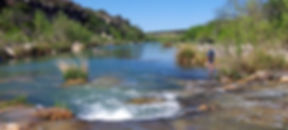Oasis Fire - then and now (part 2)
The Junction Eagle April 8, 2015 by James Murr and Scott Richardson
This is the second of three articles reviewing the OASIS Pipeline fire of April-May 2011 that burned 9,000 acres southwest of Junction. The first article reviewed the extent of the fire and the cooperative efforts of local, state, and federal governments in bringing the fire under control. This article reviews actions taken after the fire to deal with the restoration and recovery of the burned land that threatened the riparian and aquatic habitat – i.e., the South Llano River, its tributaries, and downstream areas.
The third and final article in this series will report on an April 18th workshop, which will be held at the Llano River Field Station (LRFS) at Texas Tech-Junction. The workshop will provide information on the recovery strategies that were undertaken and the types of recovery on the land. This will be four years after the fire. (One may still register by April 12th for the workshop by contacting Scott Richardson at 325-475-2271 orscottr@ctesc.net or register on-line by going to www.southllano.org.)
A Meeting of Experts
Thirty experts met in July 2011 to visit the scorched acreage and to assess practices that could contribute toward the restoration and recovery of the land. The meeting was convened by the Texas Parks & Wildlife Department (TPWD) and the South Llano Watershed Alliance (SLWA) at the LRFS in Junction. Experts were present from many agencies, as well as the private sector.
A visit by the experts to the burn site revealed little evidence of viable seeds or roots in what looked to be a sterilized environment that was void of vegetation. It was evident that there was a critical need to restore vegetation to the land, especially on steep slopes. This needed to be done as soon as possible.
The initial recommendations of the experts focused on the rehabilitation of areas that could pose a risk to personal safety and/or property. The rehabilitation was to focus on specific resources concerns (e.g., preventing erosion). An overarching goal of the recommendations was to “Do No Harm”. In this regard, land clearing by heavy equipment was to be avoided and grazing was to be deferred.
It was determined that exclosures could be used to protect re-sprouting species from browsing by wildlife. The following could also be used where practicable: check dams; log erosion barriers; fiber rolls; slash spreading (dispersing accumulations of branches and foliage over an area); and mulch when available. Steve Nelle (Natural Resources Conservation Service (NRCS), U.S. Department of Agriculture) also suggested that a seed mix be formulated for the scorched land and that landowners be given some of the seed so they could become part of the effort to identify suitable techniques for the land’s restoration and recovery.
A Workshop – Land Restoration and Recovery
In November, around four months after the meeting of experts, the SLWA facilitated and coordinated a workshop for affected and otherwise interested landowners at the LRFS. The workshop was funded by the TPWD and included an indoor program with presentations by expert speakers and a tour of “restoration and recovery demonstration sites” at the Fox Hollow Subdivision along U.S. Highway 377.
In addition to the SLWA and TPWD, representatives were present from the LRFS, the NRCS, the Texas Forest Service, the Upper Llanos Soil and Water Conservation Service, and a private company (Native American Seed). The previously mentioned seed mix had also been formulated by this time by Nelle and Bill Neiman, the owner of Native American Seed. Each attendee was given a packet of the seeds and a compact disc with information on land recovery and restoration techniques.
Workshop presentations during the morning included the following topics: overview of the fire; general effects of the fire on soil and vegetation in dry conditions; post-fire restoration and recovery practices; best land management practices; habitat evaluation, assessment, and monitoring; and documenting vegetative recovery. Also addressed were the economic impact of the fire and state and federal cost sharing programs. The presentations were made by local landowners and representatives from the above named entities and then County Judge, now State Representative, Andrew Murr.
In the afternoon, the workshop attendees toured demonstration sites at the Fox Hollow Subdivision. The sites included exclosures placed on bare ground, slash and fiber roll terracing with seeding on steep slopes, check dams on upper drainage areas, and an upland fiber blanket with seeding for erosion control.
Around six months after the workshop, on May 19, 2012, there was a follow-up field trip to the Fox Hollow demonstration sites to view the recovery of the burned land and to hear the assessment of experts on what was transpiring. Many did not anticipate seeing recovered land, but were pleased that some recovery was evident.
For example, erosion control (slash and fiber roll terracing, check dams, and fiber blankets) was shown to be effective and forbs and grasses were growing where the scorched land seed mix had been used. Most promising was the presence of native perennial grasses coming back from the roots. Although it was recognized that full restoration of the land will take many years and is dependent on many variables (e.g., rainfall), most were encouraged to see that simple restoration practices had helped with the beginning of the land’s recovery.
Upcoming April Workshop
The final article in this series will report on the aforementioned and upcoming April 18th workshop at the Llano River Field Station at Texas Tech-Junction. This will be four years after the fire.
(Note: The information in this article was compiled primarily by Scott Richardson while he served as the Board Chair for the SLWA and is also derived from material prepared by the TPWD, the Texas Forest Service, and the County of Kimble. Other contributors are Gary Garrett, Research Associate, University of Texas, and Megan Bean, Watershed Ecologist, TPWD.)




